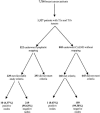Effect of lymphatic mapping on diagnosis and treatment of patients with T1a, T1b favorable breast cancer
- PMID: 12796580
- PMCID: PMC1514680
- DOI: 10.1097/01.SLA.0000071564.27229.A9
Effect of lymphatic mapping on diagnosis and treatment of patients with T1a, T1b favorable breast cancer
Abstract
Objective: To investigate the incidence of nodal metastasis in a consecutive series of patients treated at the authors' institution with highly selective criteria, and to determine the impact that lymphatic mapping and sentinel node biopsy have on the detection of nodal metastases in this carefully selected patient population.
Methods: Study patients were selected from the 7,750 breast cancer patients entered into the authors' database from April 1989 to August 2001, based on the following criteria: nonpalpable, T1a and T1b, non-high nuclear grade tumors, without lymphovascular invasion.
Results: Of the 7,750 patients in the database 1,327 (17%) were found to have T1a and T1b lesions. Three hundred eighty-nine patients were confirmed to meet all four selection criteria. This represents 5% (389/7,750) of the authors' breast cancer patients and 29.3% (389/1,327) of the authors' T1a/T1b tumors. One hundred sixty patients were diagnosed before routine use of lymphatic mapping, and only one patient had a positive axillary lymph node. Two hundred twenty-nine patients underwent lymphatic mapping and sentinel lymph node biopsy, and 10 had a positive axillary lymph node. The difference in proportions of nodal positivity between the mapped and unmapped patients was significant.
Conclusions: This study clearly demonstrates the ability of lymphatic mapping and a more detailed examination of the sentinel node to increase the accuracy of axillary staging. It has been argued that this highly selected group of breast cancer patients possessing retrospectively identified "favorable" characteristics does not require axillary staging. This select population represents only 5% of breast cancer patients in this series, and the authors do not believe they can be accurately identified preoperatively. Therefore, the authors strongly argue for evaluation of the axillary nodal status by lymphatic mapping.
Figures
References
-
- Barth A, Craig PH, Silverstein MJ. Predictors of axillary lymph node metastases in patients with T1 breast carcinoma. Cancer. 1997; 79: 1918–1922. - PubMed
-
- Chadha M, Chabon AB, Friedmann P, et al. Predictors of axillary lymph node metastases in patients with T1 breast cancer: A multivariate analysis. Cancer. 1994; 73: 350–353. - PubMed
-
- Silverstein MJ, Skinner KA, Lomis TJ. Predicting axillary nodal positivity in 2282 patients with breast carcinoma. World J Surg. 2001; 25: 767–772. - PubMed
-
- Albertini JJ, Lyman GH, Cox C, et al. Lymphatic mapping and sentinel node biopsy in the patient with breast cancer. JAMA. 1996; 276: 1818–1822. - PubMed
-
- Bass SS, Cox CE, Salud CJ, et al. The effects of postinjection massage on the sensitivity of lymphatic mapping in breast cancer. J Am Coll Surg. 2001; 192: 9–16. - PubMed
MeSH terms
LinkOut - more resources
Full Text Sources
Medical
Miscellaneous


